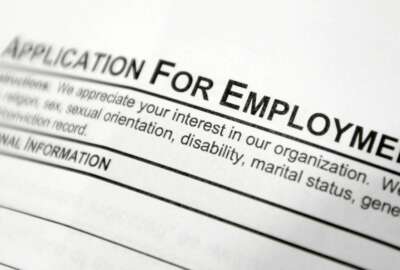

The latest executive order from the Trump administration isn't a panacea for improving the federal hiring process, human capital experts say. But the EO may hel...
As past and present administrations have tried to tackle federal hiring challenges and achieved little noticeable success, it’s easy to dismiss the latest executive order from President Donald Trump as just another similar attempt.
Past memos, executive orders and federal hiring initiatives have focused on everything from the Pathways internship program to better training for human resources professionals.
Still, complaints from Congress, chief human capital officers and good government groups and national commissions over time-to-hire and USAJobs.gov have piled up.
But the latest federal hiring EO, which the president signed late last week, doesn’t pretend to address time-to-hire concerns.
Instead, it encourages agencies to focus on improving the quality of their hires, which, if implemented properly, could eventually speed up a lengthy and frustrating federal hiring process, human capital experts say.
First, the EO instructs agencies and the Office of Personnel Management to prioritize skills over college degrees when identifying and vetting job candidates.
Educational requirements — which the administration has described as often a “poor proxy” for the specific competencies and skills agencies seek in their job candidates — should be eliminated for certain positions where it’s not legally mandated.
“It’s not necessarily going to speed up the hiring process, but it broadens the applicant pool to allow selecting officers to find better candidates,” Dan Blair, a former OPM deputy director and acting director during the George W. Bush administration, said of the EO.
Second, the EO urges agencies to expand their use of skills-based assessments when choosing and vetting candidates.
“In assessing candidates, agencies shall not rely solely on candidates’ self-evaluations of their stated abilities,” the order reads. “Applicants must clear other assessment hurdles in order to be certified for consideration.”
The order also charges OPM and agencies with reviewing and revising decades-old job classification and qualification standards for certain positions to reflect these priorities. It gives OPM four months to conduct these reviews and another two months to make any changes public.
Agencies will need clear, specific guidance from OPM to conduct these reviews, Blair said.
And OPM, which isn’t known for its expediency in drafting new policy regulations, may need more time and resources to conduct those reviews, said Jeff Neal, a former chief human capital expert for the Department of Homeland Security.
But for Neal, encouraging agencies to use skills-based assessments in identifying and vetting job candidates may hold the most promise, though federal organizations may need more resources to get the job done.
Many agencies currently rely on candidates to self-certify their skills, and those self-assessments leave applicants plenty of room to inaccurately inflate their abilities.
Take a current self assessment for a GS-12 program analyst for the Department of the Army, which includes 28 multiple-choice questions, as an example.
The vast majority of the questions ask the applicant to choose from one of five statements that most accurately describes his or her training and experiences related to the job’s requirements. The responses range from allowing applicants to say they don’t have experience with a particular task to deeming themselves as an expert.

One question asks the applicant to assess his or her skills with attending meetings and conferences.
Because these assessments don’t physically test an applicant’s ability to perform a specific task or demonstrate their abilities, many candidates say they’re an expert in everything, even when they’re not, Neal said. These applicants rise to the top of an agency’s job certification list, while the candidates who honestly certify their skills don’t earn consideration.
“The process does not catch the people who are lying,” he said. “If the process doesn’t catch and weed out the people who are lying, the process cannot work. It creates a greater likelihood that the people who are on the list are people who are willing to lie to get on the list, and the honest people get screened out.”
In guidance issued last fall, the Trump administration urged agencies to move away from self-assessments in the federal hiring process. Roughly 20% of hiring managers who took a 2015 OPM survey rated self questionnaires and assessment tools to measure candidates’ proficiency as “poor.”
“If agencies actually had good assessments, the hiring process, as bad as it is, would be much better,” Neal said.
But developing skills-based assessments will take time and resources, which agencies don’t necessarily have. In weighing in on the administration’s September 2019 federal hiring guidance, the Merit Systems Protection Board pointed to agency resource constraints in developing better assessments.
“It is, of course, easy to tell agencies to develop better assessments,” MSPB wrote. “Unfortunately, many agencies have neither the staff nor the money to do so.”
This particular EO, of course, doesn’t give agencies additional funding to develop or buy new skills-based questionnaires, and Neal questioned whether federal organizations had the time, resources and human resources experience to seek out better hiring tools.
“The vast majority of jobs use the self-assessment process, and the assessments themselves are so bad,” he said. “If you fix those assessments you could see a dramatic improvement in the process. That’s something agencies can do now; they just have to resource it and take it seriously.”
For Blair, the EO and its job classification review may serve as a conversation starter for subsequent hiring reforms, which future administrations could draw on and propose to Congress.
“Small steps should be applauded,” he said. “Just because they’re small doesn’t mean they’re without merit or impact. It’s not going to solve the massive hiring problem, but it’s a step in the right direction. And that’s a good thing.”
Copyright © 2024 Federal News Network. All rights reserved. This website is not intended for users located within the European Economic Area.
Nicole Ogrysko is a reporter for Federal News Network focusing on the federal workforce and federal pay and benefits.
Follow @nogryskoWFED


